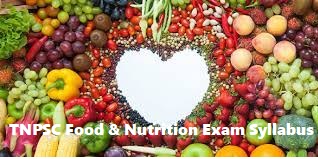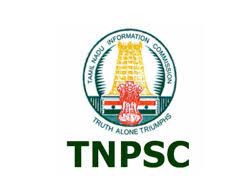TNPSC Food & Nutrition Exam Syllabus : Tamil Nadu Public Service Commission
Organisation : Tamil Nadu Public Service Commission (TNPSC)
Exam Name : TNPSC Food & Nutrition Examination
Standard : PG Degree Standard
Code : 380
Announcement : TNPSC Food & Nutrition Exam Syllabus
Website : https://www.tnpsc.gov.in/English/new_syllabus.html
What is TNPSC Food & Nutrition Exam?
Nutrition and Dietetics Tnpsc Group Question are listed in details ,most of the question have been asked in Group 1 2 2a 4 Exams. The major subjects of BSc Food Science and Nutrition’ academic curriculum include epidemiology, food science, public health, food microbiology and physiology .Most nutritionists have a qualification in nutrition, usually a degree or a Masters.
Related / Similar Syllabus : TNPSC Zoology Exam Syllabus

Syllabus For TNPSC Food & Nutrition Exam
The Syllabus For TNPSC Food & Nutrition Exam are given below,
UNIT I Human Physiology:
a) Cell and its Organelles – structure and functions.
Tissues – classification & functions. Blood – composition, functions of blood and blood cells, blood groups & blood coagulation. Cardiovascular physiology – structure and functions of heart, homeostasis of circulating body fluid, ECG, Echocardiogram, ECMO – Extracorporeal Membrane Oxygenation.
b) Respiratory system – Organs, structure & functions, Exchange of gases in lungs and tissues.
Endocrine system – pituitary, Thyroid, pancreas, adrenal medulla, adrenal cortex – hormones & functions. Gastrointestinal physiology – parts, functions, digestion & absorption.
c) Excretory system – Kidney and nephron – structure & Functions, skin – structure & functions. Reproductive system – Male & female reproductive organs & functions, menstrual cycle. Development of foetus.
d) Nervous system – Central nervous system & peripheral nervous system & functions. Special senses – Eye, Ear, Nose, Tongue – structure & functions. Immune system – Type of immunity – innate & acquired, antigen – antibody reaction, cell mediated immunity.
UNIT II Nutritional Biochemistry:
a) Carbohydrates – classification, structure, functions, digestion & absorption. Metabolism – glycolysis, TCA, cycle, HMP shunt, Glycogenesis, glycogenolysis, Gluconeogenesis. Dietary sources, deficiency & Toxicity. Inborn errors of metabolism Energy – BMR, direct & indirect calorimetry,
b) Lipids – classification, structure, characteristics, functions. Digestion, absorption & Metabolism Fatty acids – types, synthesis & catabolism. Dietary sources, deficiency & toxicity, Inborn errors of metabolism Proteins & aminoacids – classification, structure, functions, digestion & absorption. Synthesis of proteins and catabolic pathways. Dietary sources,
deficiency & Toxicity. Inborn errors of aminoacid metabolism Nucleic acids & Nucleotides – Types, structure, functions & Metabolism.
c) Vitamins – Water soluble & fat soluble vitamins – structure, functions, absorption, storage & transportation. Dietary sources, deficiency & Toxicity. Minerals – Macro & micro minerals – functions, Dietary sources, deficiency & Toxicity. Water & Electrolyte balance. Fiber – Types, Functions and Sources.
d) Biochemical Techniques – Chromatography, Electrophoresis, Colorimetry, Spectrophotometry, Flame photometry. HPLC, AAS – Instrumentation, principles & applications. Interpretation of the results of blood and urine analysis.
UNIT III Food Safety Of Food Microbiology:
a) Micro organisms important in food microbiology – moulds, yeast, Bacteria, viruses and algae.
b) Contamination and spoilage of foods – cereals & cereal products, sugar & sugar products, vegetables and fruits, meat and meat products, fish, sea foods, egg, poultry, milk & milk products.
c) Preservation of foods – Principles, Methods – High temperature, Low temperature, use of chemicals, radiation. Application of ohmic heating and high pressure processing.
d) Food borne illness – Bacterial and non bacterial food poisoning and infection. Food safety – food sanitation and Hygiene, Examination of water for bacteria. Type of Food hazards, HACCP Principles.

UNIT IV: FOOD SERVICE MANAGEMENT
a) Principles of management – Functions, tools of management – Tangible and intangible resources.
b) Organisation chart – structure, function, work improvement techniques. Personal management – concept & approaches of personal management, Recruitment, orientation, training and performance appraisal.
c) Resource management – classification, characteristics, factors affecting use of resources, resource conservation.
d) Leadership – importance, style, skills of administrators. Communication – methods, importance and barriers to communication.
UNIT V Research Methodology And Applied Statistics:
a) Research – Meaning, objectives, Types, Significance. Research Problem – Meaning, selection, Techniques involved. Research Design – Meaning & Types, Features of a good research design
b) Data collection – Primary and Secondary data – collection techniques. Data preparation – Editing, coding, classification, tabulation, diagrammatic & graphical representation, Data cleaning & adjusting.
c) Sampling design – pilot study, Types, Methods of survey – sample and
census. Research ethics, ICMR guidelines for human subjects and animal
related studies. Plagiarism check.
d) Descriptive statistics – Measure of Central Tendency, Measures of
dispersion. Correlation – Types, Interpretation of correlation co-efficient. Regression Analysis, Association of Attributes. Probability – Rules and application. Theoretical distributions – Normal & binomial distributions – characterists & applications. Test of significance – Procedure, Small & Large sample tests – t-test, F-test, chi square test, ANOVA. SPSS software in data analysis.
UNIT VI. Advanced Food Science:
a) Cereals, Pulses and Millets Structure, Composition, Processing and Nutritive Value
Rice and Rice Products, Starch Cookery – Dextrinisation and Gelatinisation Milling- Dry and Wet milling – Enrichment, Parboiling and Baking. Wheat and /wheat Products Gluten Formation and Factors affecting gluten Formation
Pulses – milling, Soaking, Germination, Decortication, Fermentation, Pulse protein concentrates, toxic constituents in Pulses. Millet and millet Products – cleaning & Dehusking, Milling and Sorting and parboiling, Bioavailability and toxicity
b) Sugar and Jaggery
Properties, Stages of Sugar Cookery, Crystallisation, Crystalline and Noncrystalline.
Palm and Sugarcane Jaggery – Economic importance and Health benefits.
Vegetables, Fruits, Fats and oils, Nuts and oil seeds Composition, effect of Cooking on pigments – chlorophils, Carotenoids, Anthocyanins, Flavanoids, Tannins and Betalins. Processing and preservation of vegetables and fruit products – Freezing, Heat Blanching, Canning, Ascorbic acid dip, Suplhur dioxide Dip, Sugar syrup, Vacuum treatment concentration and drying. Nutritive value and Browning reactions of fruits and vegetables.
Fats and oils – role of fat in cookery, rancidity, changes of fat on heating. Nuts and oil seeds, Nutritive value, importance, classification, toxins
c) Selection, processing, preservation, transportation, composition, Nutritive value, changes during cooking and spoilage of Meat and Meat products, Eggs and Poultry, Fish and other sea foods, Milk and Milk Products
d) Recent trends in Food Science and Technology
Genetically Modified Foods, Biofortification, Food Packaging and
Food safety, Space Foods and Nano Foods
Syllabus : http://www.syllabus.gen.in/uploads/pdf2022/2839-syllabus.pdf
UNIT VII Community Nutrition:
a) Nutrition and National Development
Meaning of Community, Family, Village and Block. Definition of Nutrition, Optimum Nutrition, Malnutrition – Under Nutrition and Over nutrition. Nutritional and National Development. Nutritional problems confronting India. Human Life cycle – RDA for Indians. Prevalence of Malnutrition in India. National and In Malnutrition in the International Organizations in
Combating Malnutrition in the Community. WHO, FAO, UNICEF, ICMR, ICAR, NIN, ICDS, SNP, AMP, CFTRI, Role of PHC and ESI in health care.
b) Assessment of Nutritional status in the community Direct and Indirect Methods. Anthropometry, Biochemical Assessment, Clinical Assessment, Biophysical Examination, Functional Assessment, Dietary Assessment and Vital Statistics.
c) Nutritional Deficiency Disorders Protein energy Malnutrition, Nutrition and Anemia, Iodine deficiency disorders, Vitamin – A and D Deficiency disorders. Latest Immunisation
Schedule.
d) Nutrition Education
Meaning, scope, methods, Teaching Aids used in Nutrition Education, Mass Communication Media used in Nutrition Education, Planning conducting and evaluation of Nutrition education programme.
UNIT VIII Nutrition Through Life Cycle:
a) Pregnancy preconceptual Nutrition – Physiological changes, energy cont of pregnancy, problems & complications, of nutritional requirement teenage pregnancy, risk factors for poor pregnancy, nutritional problems of nutritional. Lactation – Physiology of lactation, efficiency of milk products, nutritional and immunological components of breast milk, myths, special foods and nutritional requirements.
b) Infants – Growth and development, Nutritional requirements, feeding problems in normal and premature infants, weaning, significance, supplementary foods. Preschool – Nutritional and food requirements, physiological development, neuromuscular, hematological, behavioral characteristics, Malnutrition-vitamin A, PEM, overweight problem.
c) School children-growth, feeding school children, feeding problems, under weight, hyper activity, dental caries, packed lunch and nutritional requirements Adolescence- Growth and developmental changes, factors affecting menarchial age, peer group influence, psychological problems and challenges. Malnutrition- anemia, goiter, obesity and nutritional requirements, PCOD and its management.
d) Adult- Nutritional requirements, problems in menopause and its management.
Geriatrics – Physiological and psychological changes, eating problems, meeting nutritional requirements.
UNIT IX Therapeutic Nutrition:
a) Introduction to Diet therapy and Therapeutic Nutrition
Diet therapy: Principles of Diet Therapy, nutritional care process, Basic concepts of diet therapy and planning a diet. Therapeutic adaptations of normal diet. Routine Hospital Diets: clear fluid, full fluid, soft and normal diet, Pre-operative and post-operative diets. Special feeding techniques – Parenteral and enteral feeding
Dietitian: Role of dietitians in Nutritional care, planning and diet counselling
b) Diseases of GI Tract
Aetiology, symptoms, complications and principles of diet management in peptic ulcer, gastritis, constipation, intolerance, Inflammatory Bowel Disease, Irritable Bowel Syndrome (IBS) Gastroesophagal reflux disease (GERD).
Fevers and infections – Typhoid, Malaria and Tuberculosis – Causes, Symptoms, metabolic changes and dietary management in fevers and infection.
Liver – Nutritional care for diseases of Liver and biliary system:
Jaundice, Cirrhosis of liver, Viral Hepatitis, Hepatic Encephalopathy,
Role of alcohol in liver disease.
Diseases of Gall Bladder and Pancreas – Cholelithiasis,
Cholecystitis, Cholecystectomy, Acute and chronic Pancreatitis –
Aetiology, symptoms, complications and principles of diet
management
c) Diet in Diabetes Mellitus and cancer
Dietary management of Diabetes mellitus – Prevalence, Types, Etiology
and Signs and Symptoms, Factors affecting normal blood Glucose
levels, Impaired glucose homeostasis, Diagnostic test for diabetes,
Complications of diabetes – macro-vascular and micro-vascular
Management of Diabetes, Dietary management of diabetes.
Cancer – Carcinogenesis – pathogenesis and progression of cancer, Types, Symptoms, Diagnosis. Chemotherapy, Radiation and Surgery
Etiology, clinical signs and symptoms of Kidney diseases – Glomerulonephritis, Nephrotic Syndrome, Acute Renal Failure (ARF), Chronic Renal Failure (CRF), End Stage Renal Disease (ESRD) – Dialysis and kidney Transplant.
d) Dietary management in cardiovascular disease – Etiology, Types, symptoms, complications, diagnostic test and principles of diet management for hyperlipidemia, Hypertension, Atheroclerosis, Ischemic Heart Disease, Congestive Cardiac Failure. Acute and Chronic heart
disease. Role of fat in development of atherosclerosis – High fibre, low fat, sodium restricted diet. Nutrient and drug interaction in cardio vascular diseases. Diet in surgical conditions and Burns. Classification, Complication, Dietary management Malabsorption syndrome – Restricted diets – Lactose, Sucrose, gluten etc Allergies – Food allergy and intolerance – Mechanism, factors influencing, symptoms, tests for allergy, Nutritional care and Elimination and skin disorder Weight Management Obesity, Aetiology, assessment, types, complications and
principles of diet management.
Under Weight: Aetiology, limitations, complications and
principles of diet management
UNIT X FINANCIAL AND MARKETING MANAGEMENT
a) Introduction to Financial and Marketing Management
Nature, Scope and objectives – financial function – profit vs wealth maximization – Roles and responsibilities of a financial Manager / corporate financial officer – Marketing function
Classification of markets Difference between Marketing and selling – Product, Price, Place, Promotion, People, Process and physical Environment
b) Financial Decisions
Sources and Types of capital Cost of different types of capital – capital budgeting, cash budgets, break even analysis – Management of working capital Roles and responsibilities of a Financial Manager, Corporate Financial Manager
c) Capital Investment Decisions
Planning and control of Capital Expenditure – Capital budgeting process -Cost of Capital and its application in Capital Budgeting decisions Pricing Policies – Importance of Pricing, Factors affecting pricing, Wholesale and retail Pricing, Food and Beverage costing and Pricing Financial Accounting Simple and double entry book keeping, Management accounting, and
decision making Working capital Management – Concept – Need and Influencing factors – Estimation – working capital – Inventories and receivables Management – Management of cash
d) Pricing and Branding
Meaning – Objectives of pricing – factors influencing pricing and decisions – Impact on decision making – Procedure for price determination Branding Definition – Types – Importance – Merits and Demerits of branding Difference between branding and labelling – packaging and labelling – Types of labelling – labelling strategies